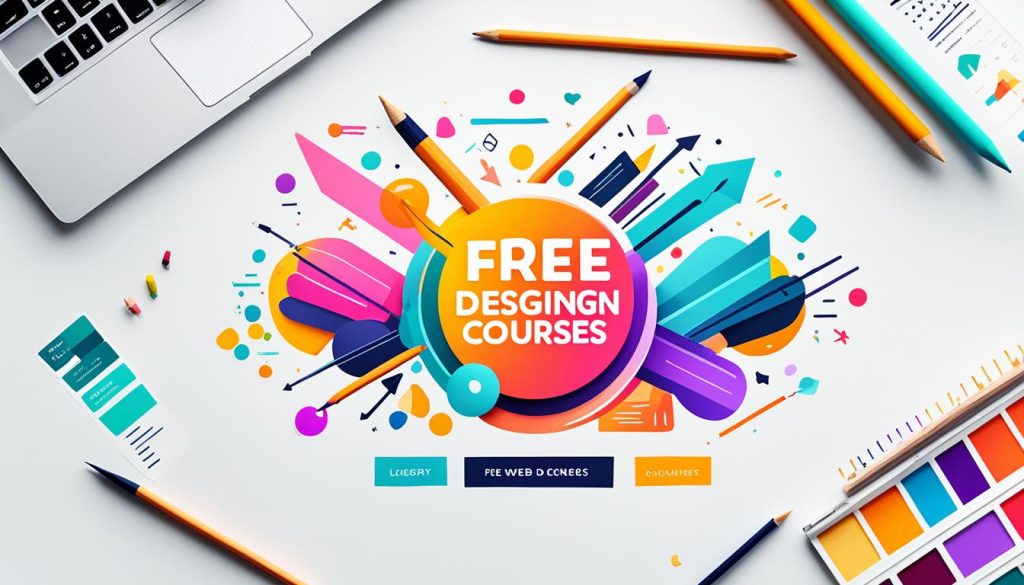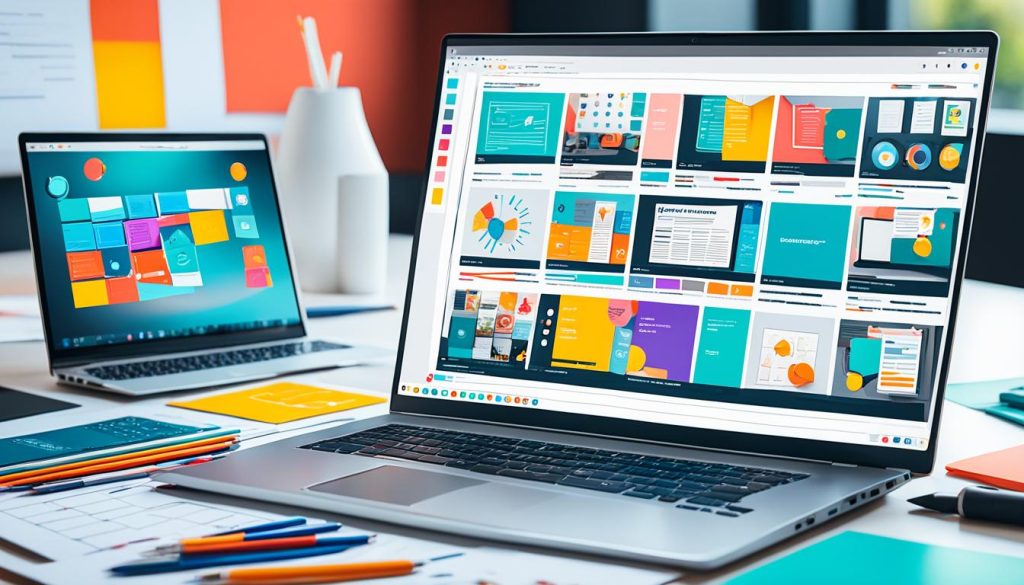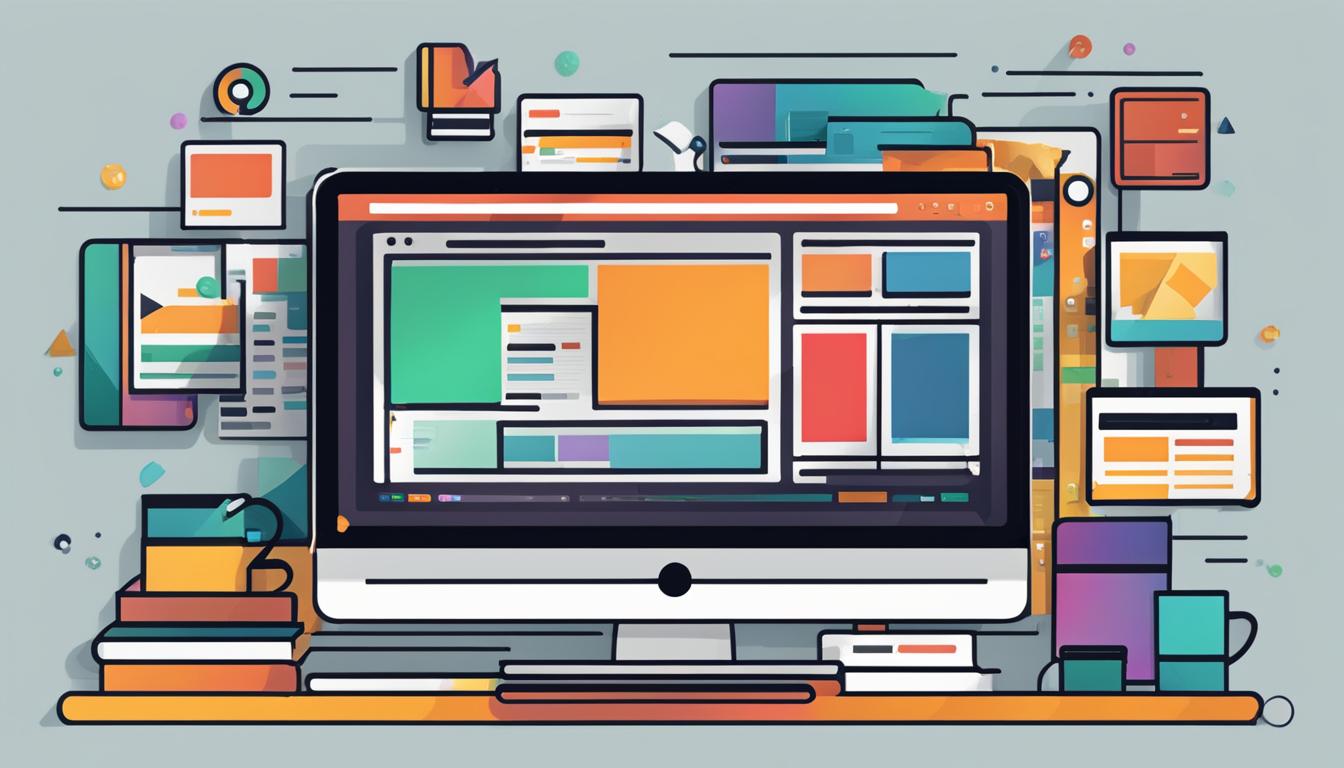Building website courses
Did you know that 48% of businesses believe that having a website built is the most important digital marketing skill? With the increasing demand for online presence, web development training has become essential for individuals and businesses alike. Whether you aspire to design stunning websites or gain expertise in HTML and CSS, enrolling in building website courses can open a world of opportunities.
Key Takeaways:
- Building website courses offer a wide range of topics, from HTML and CSS to website creation and user experience design.
- Choose a web design course that aligns with your educational goals and the specific skills you want to acquire.
- There are free web design courses available for beginners, covering the basics of HTML and CSS.
- For advanced learners, paid web design courses provide in-depth training on real-world coding and responsive design.
- Online web design video courses with hands-on projects offer practical learning experiences for aspiring designers.
Choose the Web Design Course That Aligns Best With Your Educational Goals
When it comes to selecting a web design course, it’s essential to consider your educational goals and the specific skills you want to acquire. With options ranging from front-end web development to HTML and CSS, web development tools, and more, different courses emphasize different aspects of web design. You may also find courses that cover additional topics like computer programming, user experience design, full-stack web development, interactive design, and visual design. By choosing a course that aligns with your interests and goals, you can ensure that you make the most of your learning experience.
Front-end web development courses focus on building the visible parts of websites, using HTML and CSS to create the layout, formatting, and visual elements that users interact with. These courses are an excellent choice if you want to specialize in the design and development of front-end interfaces.
On the other hand, if you’re interested in a broader approach to web design, you might consider courses that cover computer programming, user experience design, and full-stack web development. These courses provide a more comprehensive understanding of web design principles and equip you with the skills needed to create robust and dynamic websites from start to finish.
For those who have a passion for interactive design and want to bring their web creations to life, there are courses that focus on programming principles, computer graphic techniques, and user interaction. By learning these skills, you’ll be able to design websites that not only look great but also provide an engaging and intuitive user experience.
In addition to the technical aspects of web design, courses on visual design can help you develop a keen eye for aesthetics and composition. These courses explore color theory, typography, and other design elements to ensure that your websites have a visually appealing and cohesive look.
Ultimately, the choice of which web design course to take depends on your interests and educational goals. It’s essential to evaluate the course curriculum and learning outcomes to ensure that they align with what you hope to achieve. By selecting a course that caters to your specific needs, you’ll be setting yourself up for success in the exciting field of web design.
Now that you have a sense of the various aspects of web design and the educational options available, it’s time to explore specific courses that suit your needs. In the next section, we’ll discuss some of the top free web design courses for beginners.
Top Free Web Design Courses for Beginners
If you are a beginner looking to learn web design, there are several free courses available that cover the basics. These courses typically start with an introduction to HTML and CSS, teaching you the fundamentals of web structure, typography, and media elements. They also provide guidance on how to create responsive designs that adapt to different screen sizes. By taking advantage of these free courses, you can build a solid foundation in web design without having to invest any money.
One of the top free web design courses for beginners is Codecademy’s Learn HTML. This course offers interactive lessons that walk you through the process of building a website using HTML. You’ll learn how to structure web pages, create headings and paragraphs, add links and images, and more.
Another great option is the freeCodeCamp Responsive Web Design Certification. This course covers HTML, CSS, and responsive design principles. It includes hands-on projects and coding challenges to help you practice and solidify your skills.
If you prefer video-based learning, the YouTube playlist by The Net Ninja is a fantastic resource. This playlist takes you through HTML and CSS from scratch, teaching you how to create web pages and style them using CSS selectors, properties, and values.
Whatever your preferred learning style may be, there are plenty of free web design courses available to help beginners get started. Whether you choose an interactive platform like Codecademy, an in-depth certification course like freeCodeCamp, or a comprehensive YouTube playlist like The Net Ninja, these resources will provide you with the knowledge and skills you need to begin your web design journey.

| Course | Platform | Course Description |
|---|---|---|
| Codecademy’s Learn HTML | Codecademy | Interactive lessons on HTML and web page structure |
| freeCodeCamp Responsive Web Design Certification | freeCodeCamp | Comprehensive course on HTML, CSS, and responsive design |
| YouTube playlist by The Net Ninja | YouTube | Video-based tutorials on HTML and CSS |
Best Paid Web Design Courses for Advanced Learners
As an advanced learner in web design, you might be looking for paid courses that offer comprehensive training to further enhance your skills. These courses go beyond the basics and delve into advanced topics that can take your web design abilities to the next level.
One popular paid course is “Web Design for Beginners,” which not only caters to beginners but also provides a solid foundation for advanced learners. It covers real-world coding using HTML and CSS, allowing you to gain hands-on experience in creating functional websites. This course also emphasizes responsive design principles, teaching you how to make your website adapt seamlessly to various screen sizes.
Another course worth considering is “CSS Layouts and Flexbox Mastery.” This course focuses on CSS layouts, equipping you with the knowledge and skills to create visually appealing web designs. It delves into advanced techniques, including flexbox, a powerful CSS layout model that allows you to build flexible and responsive designs with ease.
If you’re interested in learning a popular front-end framework, “Bootstrap for Web Designers” is an excellent choice. This course teaches you how to utilize Bootstrap, a widely-used framework that streamlines the web design process. You’ll learn how to leverage its pre-built components and responsive grid system to design professional-looking websites efficiently.

Investing in these paid web design courses enables you to gain advanced knowledge and expertise in the field. By learning from industry professionals and practicing real-world coding, you can sharpen your skills and stay ahead of the curve in the rapidly evolving web design industry.
| Course | Key Features |
|---|---|
| Web Design for Beginners |
|
| CSS Layouts and Flexbox Mastery |
|
| Bootstrap for Web Designers |
|
Online Web Design Video Courses with Hands-On Projects
If you’re looking to learn web design in a hands-on and engaging way, online web design video courses are the perfect choice. These courses provide a dynamic learning experience through video lessons, interactive elements, and practical projects. By enrolling in these courses, you can gain valuable skills in HTML and CSS, website creation, responsive design, and more.
One of the key advantages of online web design video courses is the ability to learn at your own pace. With video lessons, you can pause, rewind, and replay as needed, ensuring that you fully grasp each concept before moving on to the next. This flexibility allows you to tailor your learning experience to your individual needs and schedule.
These courses also provide step-by-step tutorials on HTML and CSS, teaching you the fundamentals of web design. You’ll learn how to create and structure web pages using HTML, and apply styles and layouts using CSS. By following along with these tutorials, you’ll gain practical experience in website creation and develop a strong foundation in web design principles.
Moreover, online web design video courses often include hands-on projects that allow you to apply what you’ve learned in a real-world context. These projects simulate the experience of working on a web design project, giving you the opportunity to practice your skills and build a professional portfolio. By completing these projects, you’ll not only enhance your technical abilities but also showcase your work to potential employers or clients.
Another benefit of these courses is the focus on responsive design principles. As more and more users access websites from different devices, it’s crucial to design websites that adapt seamlessly to various screen sizes. Online web design video courses teach you how to create responsive websites that provide a consistent user experience across desktops, tablets, and mobile devices.
To ensure your understanding of the material, these courses often include interactive quizzes. These quizzes test your knowledge and reinforce the concepts covered in the video lessons. By actively engaging with the content, you can solidify your understanding and identify areas for further improvement.
Overall, online web design video courses with hands-on projects offer a comprehensive and effective way to learn web design. They provide a combination of visual instruction, practical application, and interactive elements, making the learning process engaging and enjoyable. By enrolling in these courses, you’ll acquire the skills and confidence to create professional and visually appealing websites.
| Benefits of Online Web Design Video Courses with Hands-On Projects |
|---|
| Flexible learning at your own pace |
| Step-by-step tutorials on HTML and CSS |
| Hands-on projects for practical application |
| Focus on responsive design principles |
| Interactive quizzes to test knowledge |
Essential Tools and Soft Skills for Web Design Success
In the world of web design, technical skills are just one piece of the puzzle. To truly excel in this field, web designers need to master a range of essential tools and soft skills. These tools and skills are the building blocks of success, enabling designers to create stunning websites that not only look great but also deliver a seamless user experience.
Essential Tools for Web Design
When it comes to web design, having the right tools at your disposal can make all the difference. Here are some essential tools that every web designer should be familiar with:
- HTML and CSS editors like Adobe XD, Sketch, and GIMP: These tools are used for basic illustration and photo editing, allowing designers to bring their creative visions to life.
- Interaction design tools like Adobe XD: These tools help designers create interactive and engaging user experiences, enhancing the overall functionality of websites.
- Local development environments for prototyping and working with content management systems: By using local dev environments, designers can test and refine their designs before deploying them to the live website.
Soft Skills for Web Design Success
In addition to technical expertise, web designers need to cultivate a range of soft skills to thrive in the industry. These skills not only enhance the quality of their work but also strengthen client relationships. Here are some key soft skills for web design success:
- Consumer Psychology: Understanding consumer psychology allows designers to create websites that resonate with their target audience, driving higher engagement and conversions.
- Pricing Projects: Knowing how to price web design projects accurately ensures that designers are adequately compensated for their work while staying competitive in the market.
- Client Proposals: Creating compelling client proposals helps designers effectively communicate their ideas, showcase their capabilities, and win over clients.
By mastering both the essential tools and soft skills, web designers can position themselves for success and stand out in a competitive industry. These skills empower designers to create visually stunning and highly functional websites that leave a lasting impression on users.
Do Qualifications Matter in Web Design?
In the field of web design, traditional qualifications such as university degrees hold less weight compared to other industries. Instead, web designers are often evaluated based on their portfolio sites, which serve as a platform to showcase their recent work and highlight their design and development skills. A strong portfolio, along with a well-designed personal website, can effectively demonstrate a designer’s capabilities to potential clients.
While qualifications can provide a foundation of knowledge, it is the practical skills and portfolio that truly exhibit a web designer’s abilities. Clients are more interested in seeing tangible examples of a designer’s work and assessing their design and development skills through past projects. This judging criteria allows clients to evaluate the designer’s creativity, problem-solving abilities, and the quality of their work.
By focusing on a designer’s recent work and portfolio sites, clients can gain insights into their ability to create visually appealing and functional websites. It allows them to assess the designer’s expertise in areas such as user experience, responsive design, accessibility, and overall aesthetics.
Web designers should aim to continuously update their portfolio with recent work that showcases their evolving skills and expertise. It is important to showcase a range of projects, highlighting different design styles, industries, and functionalities to demonstrate versatility.
| Judging Criteria | Description |
|---|---|
| Visual Appeal | The design should be aesthetically pleasing and visually engaging. |
| User Experience | The website should provide a positive and intuitive user experience. |
| Functionality | The website should be fully functional across different devices and browsers. |
| Creativity | The design should showcase originality and creativity. |
| Problem-Solving | The designer’s approach to addressing challenges and solving problems. |
While qualifications are not the sole determining factor in web design, they can still provide a solid foundation of knowledge. Pursuing web design courses and certifications can enhance a designer’s understanding of design principles, best practices, and industry trends. However, it is crucial to supplement these qualifications with practical skills and a diverse portfolio to truly showcase one’s abilities as a web designer.
Conclusion: Start Your Journey in Web Design Today
If you have a passion for web design, there is no better time to start your journey than today. The web design industry offers numerous opportunities for growth and advancement, and with the abundance of online courses available, you can gain the practical skills and hands-on experience needed to succeed.
Whether you are a beginner or an advanced learner, online courses provide a flexible and accessible way to learn. Free courses are a great option for beginners, allowing you to learn the basics of web design without any financial investment. For those looking to take their skills to the next level, paid courses offer more comprehensive training and in-depth knowledge.
By continuously honing your skills and staying up-to-date with the latest industry trends, you can become a successful web designer. The key is to keep learning, practicing, and experimenting with different techniques and tools. With dedication and hard work, you can elevate your career to new heights and make your mark in the exciting world of web design.
So, what are you waiting for? Begin your web design journey today and unlock a world of possibilities. Take advantage of the online courses available, acquire practical skills, gain hands-on experience, and embark on a fulfilling career in the dynamic web design industry.
FAQ
What are building website courses?
How do I choose the right web design course for me?
Are there any free web design courses for beginners?
What are the best paid web design courses for advanced learners?
Are there online web design courses with hands-on projects?
Besides technical skills, what other tools and soft skills are important for web design success?
Do qualifications matter in web design?
How can I start my journey in web design?
- How Strategic SEO Drove Growth for a CPAP E-commerce Brand - July 24, 2025
- Top 3 SEO Companies in Toronto: An Analytical Comparison - July 23, 2025
- SEO for Entry Door Services - April 24, 2025





















Post Comment
You must be logged in to post a comment.